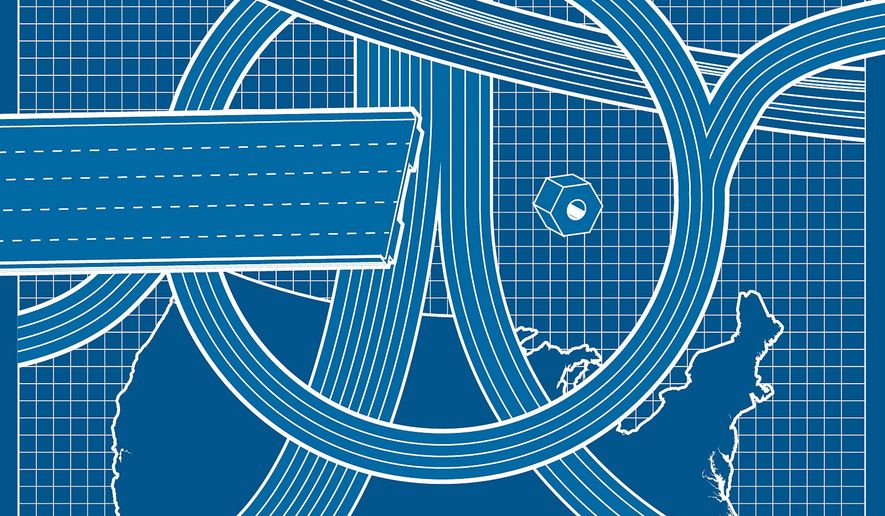OPINION:
America’s transportation infrastructure is the backbone of our world-leading economy. It’s a key factor in productivity, providing our nation with unprecedented mobility and profoundly affecting our quality of life. When President Trump assumed office, he understood that these gains were jeopardized by deteriorating infrastructure and a failure to keep pace with emerging technologies.
During this administration, the U.S. Department of Transportation has played a vital role in modernizing transportation systems and strengthening America’s competitiveness. Rebuilding, refurbishing, and revitalizing the nation’s infrastructure became a top priority. Nearly $300 billion has been invested to improve America’s infrastructure — from highways to airports to seaports.
After years of neglect and underinvestment in America’s heartland, the Department of Transportation has made it a priority to ensure that federal resources are accessible to everyone, including rural communities. Urban areas used to receive over 80 percent of awards from the Department of Transportation’s largest competitive grant programs, while rural communities received just 20 percent. This has changed with rural areas now receiving their fair share.
The Department of Transportation has also invested more than $2.1 billion in Opportunity Zones to improve infrastructure in underserved communities, create jobs, and boost local economies.
That’s just the beginning. For decades, one of the biggest obstacles to improving America’s transportation systems has been mountains of bureaucratic red tape in Washington, D.C. That’s why the U.S. Department of Transportation has eliminated 12 regulations for every new one put on the books, saving the economy and consumers more than $93 billion.
This administration is transforming a broken transportation permitting process by streamlining decision-making through modernizing the National Environmental Policy Act regulations and adopting a One Federal Decision framework for environmental review. Before President Trump assumed office, paperwork for highway projects had ballooned to an average of nearly 750 pages in length. The Department of Transportation has cut the federal permitting timeline for major projects dramatically so that reviews are expedited and don’t linger for decades.
This administration has worked to remove the federal government as an impediment to innovation, after decades of relentless bureaucracy. The Transportation Department has greatly advanced the safe integration of drones into our national airspace and provided a clear regulatory path for the safe development and integration of revolutionary automated vehicle technologies.
This administration has streamlined commercial space licensing so that America’s aerospace industry can continue to innovate and thrive. At the Department of Transportation, the new Non-Traditional and Emerging Transportation Technology (NETT) Council was created to identify and resolve jurisdictional and regulatory gaps that may impede the safe deployment of emerging technologies.
To ensure America continues to have the safest transportation system in the world, a number of key regulatory actions were instituted. “Hours-of-service” regulations that dictate the driving schedules of commercial truckers were modernized to give truck drivers additional flexibility and keep America’s roads safe. America’s energy productivity was enhanced by allowing liquefied natural gas to be transported by rail, while preserving safety. American auto manufacturing was boosted by revising costly, increasingly unachievable and job-killing fuel mileage mandates and CO2 emissions standards.
The Department of Transportation has also responded swiftly and decisively to lift up communities that have suffered from natural disasters. In 2017, a fire on Interstate 85 in Atlanta resulted in a bridge collapse and the shutdown of a major Southeast transportation artery. Within hours, the U.S. Department of Transportation approved $10 million in emergency relief funds to assist in repairing the bridge, and Federal regulatory requirements were expedited to ensure timely execution of contracts and funding. Thanks to unprecedented collaboration between the federal, state and local governments, the bridge reopened just 49 days later — ahead of schedule and below budget.
During the early days of the COVID-19 public health emergency, the Department of Transportation issued more than 200 temporary regulatory relief actions and distributed $40 billion to keep our transportation systems safe and operational.
At the U.S. Department of Transportation, we know that a strong infrastructure network is the foundation of a thriving economy. That’s why this administration is committed to breathing new life into our highways, railways and ports. Together, we’re working to build a stronger America — and delivering on the promises we made.
• Elaine L. Chao serves as U.S. secretary of Transportation.




Please read our comment policy before commenting.